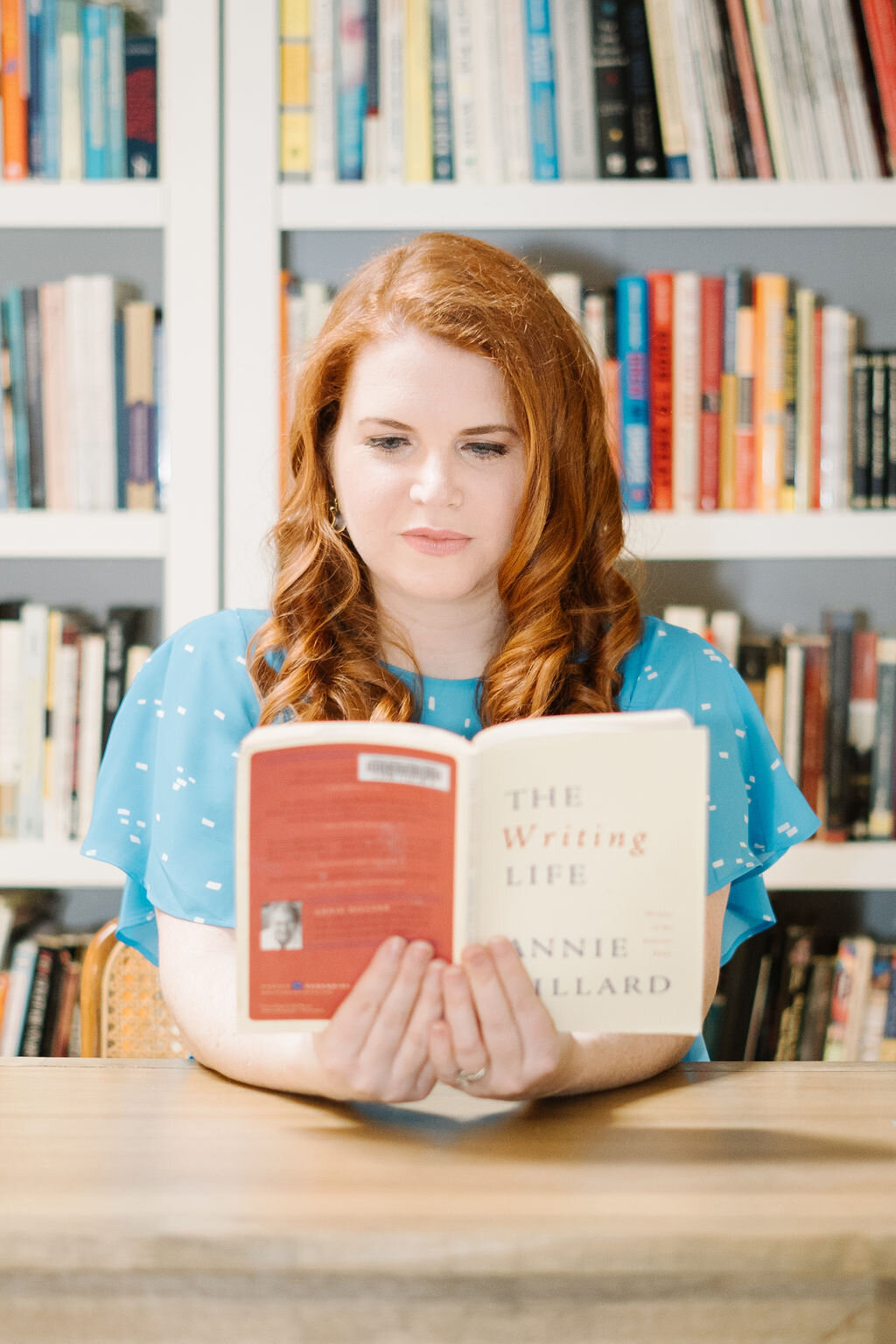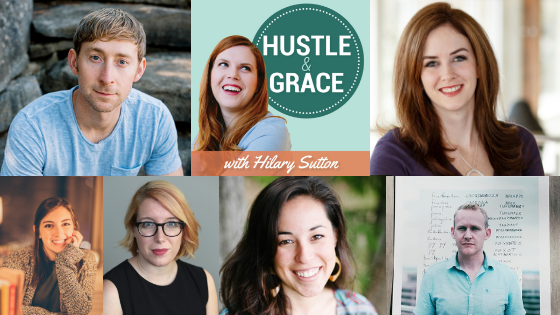(You can find quick recaps of 1-6 here).
Have I mentioned what joy this podcast is giving me?
Now, honestly, as awesome as that is, it's not really the point of the podcast. It’s about bringing you value, takeaways, and inspiration, but an awesome bonus has been how totally delightful it is to dream up each episode, talk with fascinating people, learn a TON, and then share it with the world. Thank you, thank you, thank you for listening!
If you've taken a little summer vacay from your podcast listening routine, here's the dish on what you'll want to catch up on ASAP:
Episode 7: Caitlin Pyle began her work-at-home journey after getting brutally fired from her $16-per-hour corporate job in 2011. She quickly replaced her lost income by freelancing as a proofreader. Then she transitioned to helping others build their own work-at-home incomes through her blog, ProofreadAnywhere.com and later through WorkAtHomeSchool.com. Through plenty of hustle and grace, Caitlin's freelance business evolved into the multimillion-dollar media company it is today.
In this episode, Caitlin shares tips she swears by in running her own business and creating the life of her dreams. We discuss the exciting project that brought us together: WorkAtHomeSchool.com.
More About Caitlin: https://caitlinpyle.co/
Caitlin’s podcast: Work-At-Home Heroes
Episode 8: Lisa Rowan is a senior writer and on-air analyst at The Penny Hoarder, one of the largest personal finance websites in America. She also cohosts Pop Fashion, a top-rated weekly podcast about the business of fashion and culture. A former full-time freelance writer and vintage shop owner, she is well versed in the gig economy and the small-business landscape. Her financial advice has been featured in Women’s Health, Family Circle, Refinery29, Real Simple, The New York Times, and NBC News.
In this episode Hilary brings Lisa, millennial finance expert, all her burning questions about budgeting on multiple income streams, what millennials need to know about saving, and the finance trends everyone under 40 should be paying attention to.
Recommendations from Lisa:
ThePennyHoarder.com
Get Money by Kristin Wong
Broke Millennial by Erin Lowry
Planet Money
Connect with Lisa on Twitter and Instagram @LisaTella.
Episode 9: Susan Shain is a freelance writer and digital nomad who's been traveling around the world since 2008. She's written about personal finance, travel, and food for outlets like The New York Times and CNN, and does content marketing writing for businesses of all sizes. She's also the founder of WhereToPitch.com, a website for freelance writers, and author of a pay-what-you-want eBook called "The Ultimate Guide to Seasonal Jobs: How to Have Fun, Make Money, and Travel the World."
In this episode, Susan shares how she has made a living living working in locations all over the world. She shares her tips for breaking into seasonal work and freelance writing and why community is a critical component of self-care for digital nomads and seasonal workers alike.
Recommendations from Susan:
Duolingo
Trello
The Art of Nonconformity by Chris Guillebeau
CoolWorks.com
Pimsleur
Connect with Susan at SusanShain.com and on Twitter at Susan_Shain.
Episode 10: Austin Graff leads talent marketing, brand, and social media for The Washington Post and is a contributor to On Parenting, news, advice, and essays for parents from The Washington Post. Prior to joining The Washington Post, Austin led digital, social, and influencer marketing for Coca-Cola’s Honest Tea brand, America’s #1 organic iced tea company. He started out his career leading social media and celebrity relationships for International Justice Mission, the largest human rights organization in the world. After growing up in Russia and Kazakhstan and attending boarding school in Germany, Austin came to the USA for university. He now proudly lives in Washington, D.C. with his wife, baby daughter, and two roommates.
In this episode, Austin talks about his career at The Washington Post, Honest Tea, and International Justice Mission. He also unpacks his unique philosophy of living with roommates while parenting, his time management hacks, and how he cultivates boundaries and balance in his life.
Connect with Austin on Instagram and Twitter.
Episode 11: The Truth About Freelancing: In this episode, I unpack the state of freelancing in the U.S., the drawbacks of freelancing, the benefits, and 10 characteristics of people who thrive as freelancers. If you want to know more about my story and experience as a freelancer, go here.
Connect with me on Twitter, Instagram, and Facebook.
Episode 12: Ashley Gorley has written 37 #1 singles and has had more than 300 songs recorded by artists such as Luke Bryan, Carrie Underwood, Florida Georgia Line, Blake Shelton, Brad Paisley, Jason Aldean and Darius Rucker. He was named the ASCAP Country Songwriter of the Year in 2009, 2014, 2015, 2016, and 2017, Billboard Country Songwriter of the Year in 2013, 2016, and 2017, and the NSAI Songwriter of the Year in 2013, 2016 and 2017. Gorley has been nominated for multiple Grammy and CMA and ACM Awards, and has received the CMA’s Triple Play Award eleven times in his career, which recognizes songwriters with three or more #1 songs in one year. In 2016, he became the first songwriter to be honored with three CMA Triple Play Awards in a single year, for earning nine chart-topping songs in a 12-month period. In 2011, Gorley formed Tape Room Music, a publishing company with a focus on artist development. Writers for Tape Room Music have already celebrated twelve #1 songs and eight top ten singles by artists such as Florida Georgia Line, Sam Hunt, Keith Urban, and Dustin Lynch.
At just 41, Nashville songwriter Ashley Gorley has written a mind-boggling 37 #1 hits. He has writing credits on over 300 recorded songs. Hilary got to sit down with the prolific songwriter, publisher, and producer to learn more about the hitmaker, what his day-to-day life is like, and why he prefers for Carrie Underwood to not do the singing in a writing session.
Learn more about Ashley's publishing company, Tape Room Music.
Listen to the Spotify playlist of Ashley's #1 songs.
Episode 13: Melissa Guller, is the Head of Special Projects at Teachable - an online tool that allows anyone to create and sell their own online courses - and ever since she launched her first side hustle in 2015, Melissa has been hooked on online entrepreneurship and empowering people to go for their big, awesome dreams. A bit of a side hustle queen herself, Melissa has been a top-rated instructor at General Assembly NYC for 2+ years, and she has 1300+ students currently enrolled in her Skillshare course, “What Great Managers Do Differently.” Most recently, Melissa founded The Kindling, a community for millennial women building online businesses, blogs, and podcasts they love.
Melissa Guller has made a career out of helping people monetize their expertise online. In this episode, Melissa and Hilary discuss tools to create online courses, Melissa's side hustle ventures, and why she swears by a "relaxed" list to avoid burnout.
Connect with Melissa on Instagram.
There is so much more to come in upcoming episodes I'm thrilled to share with you! Make sure you don't miss an episode by subscribing: Apple Podcasts | Android | Google Play | Stitcher | RSS






